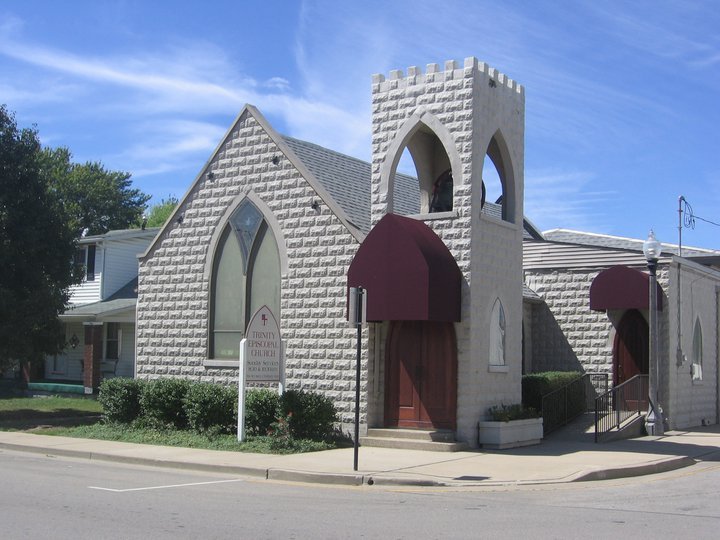Our Misson
The mission of Trinity Episcopal Church is to be a healing and reconciling presence in our community in the name of Christ. Through worship, education, fellowship, pastoral care, and service, we seek to develop what God has given us as individuals and as a community and use these gifts to serve others.
History of Trinity
Trinity Episcopal Church was originally organized on Epiphany, January 6,1840 in Lawrenceburg, Indiana. Those present were Rt.Rev. Jackson Kemper, Bishop of the Missionary Diocese of Indiana, and Rev. Thomas C. Pitkin, Rector of the new church, as well as three communicants. Trinity Church held services until 1857. Trinity was located on Walnut Street and was situated on a tract of real estate 29 feet wide and 44 feet in length. Trinity quit holding services in 1857 partially as the result of the ill health of the Bishop of the Diocese of Indiana, Rt.Rev. George Upfold.
Various persons from both Lawrenceburg and Aurora in 1874 requested the formation of an Episcopal church in each of their communities. On April 7, 1874, Rt.Rev. Joseph C. Talbot, Bishop of the Diocese of Indiana, held an Episcopal service at the Young Men’s Christian Association in Aurora, thus establishing Calvary Church, later St. Mark’s Church in Aurora. On June 18, 1874, Bishop Talbot held a service in Lawrenceburg, thus re-establishing Trinity Church. Shortly thereafter, Trinity Church on Walnut Street was repaired and conditioned for use as a church. A rector was appointed for the two churches, Rev. Wm. H. Throop. Aurora and Lawrenceburg are in close proximity of each other being only slightly less than five miles apart. Appointment of the same rector for the two churches made common sense.
St. Mark’s Church was constructed opposite the Aurora Methodist Church on Third Street in Aurora in 1877 and was of timber gothic design. A rectory was also constructed on the same lot as the church. The rectory was to serve both Trinity and St. Mark’s until the churches merged in 1907.
Both churches had active guilds and were responsible for many oyster, strawberry and other festivals. The Aurora church in an ecumenical manner with members of other churches performed sacred music programs as well as other music festivals during its existence. In fact, St. Mark’s Church made a strong cultural contribution to the Aurora community in latter 19th century.
The location of Trinity Church on Walnut Street was sold in 1906, and the real estate on which St. Mark’s was located was sold in 1908. The present Trinity Church at the corner of Center and Lake Streets in Lawrenceburg was consecrated on October 28, 1906. St. Mark’s Church in Aurora merged with Trinity Church with all the members of St. Mark’s Church becoming members of Trinity Church. This was made possible due to the construction of a light rail line from Aurora to Cincinnati which provided passenger service to and from Lawrenceburg and the invention of the automobile. Trinity Church still uses the magnificent wooden altar which had been in use at St. Mark’s.
Trinity Church became quite active in the community with its guild and with a Red Cross Chapter during World War I. In fact, the present chalice which we use for communion was the result of a silver drive among parishioners of the church at around the time of World War I. The silver was used to construct a new communion chalice for the church.
Trinity Church continued on its way and survived the Great Depression, the 1937 flood and World War II. However, Trinity Church remained a mission church with many changes in vicars who served the church. An attempt was made to rectify the situation with the formation of the Tri-Parish West Ministry which included Trinity Church from the Diocese of Indianapolis and St. Andrew’s Church, Addyston, Ohio, and Church of the Resurrection, Sayler Park (Cincinnati), Ohio from the Diocese of Southern Ohio. The idea behind this was that the three churches could together have one rector and have a stronger clergy position. The Tri-Parish West Ministry until 1985, when St. Andrew’s Church was merged with Church of the Resurrection, which resulted in a Bi-Parish organization. Later, this was dissolved. However, with strong clergy such as Rev. Mary Taflinger who served Trinity for 25 years ending in June 2021, Trinity began to prosper again.
Respectfully submitted,
John D. Mitchell

